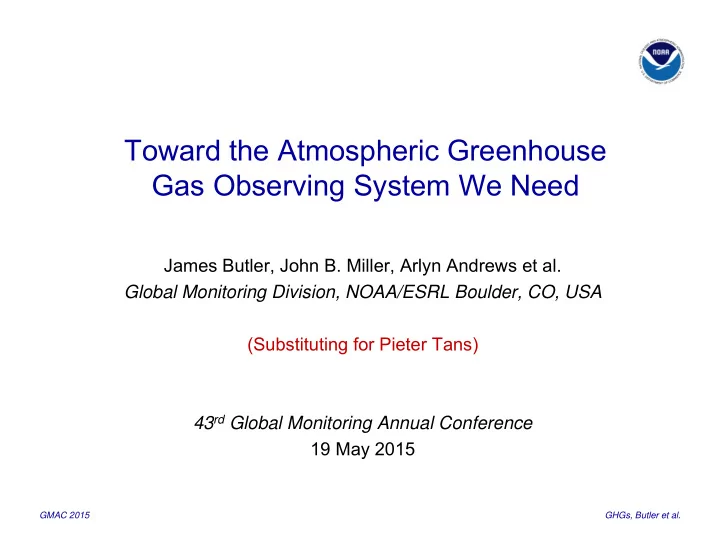

Toward the Atmospheric Greenhouse Gas Observing System We Need James Butler, John B. Miller, Arlyn Andrews et al. Global Monitoring Division, NOAA/ESRL Boulder, CO, USA (Substituting for Pieter Tans) 43 rd Global Monitoring Annual Conference 19 May 2015 GMAC 2015 GHGs, Butler et al.
The Problem GMAC 2015 2 GHGs, Butler et al.
Long lived Gases Radiative Forcing – Why we have climate change GMAC 2015 3 GHGs, Butler et al.
Atmospheric CO 2 - The Primary Driver of Climate Change Pre-industrial level of CO 2 was 280 ppm • Atmospheric CO 2 continues + 75 ppm to increase every year within 50 years The trend is largely driven by fossil fuel emissions • The growth rate increases decadally Variability is largely driven by the Earth System • The Earth System continues to capture 50% of emissions Despite the increase in emissions Do we understand carbon cycle? GMAC 2015 4 GHGs, Butler et al.
Proposed Solutions GMAC 2015 Page 5 GHGs, Butler et al.
Recent Happenings re: GHGs • IPCC AR5 reinforces conclusions of AR4 Climate is changing GHGs are causing it Increasing atmospheric CO 2 is causing ocean acidification RF keeps going up, driven mainly by increasing CO 2 • Emission reduction commitments still being made Europe doubling down by 2030 US-China agreement States, regions, and businesses making commitments Enabling programs appearing GMAC 2015 6 GHGs, Butler et al.
Number Games . . . • Everyone makes a commitment • They are using different baselines • They are using different approaches • Exports and imports come into play • Offsets and tradeoffs are engaged (Page is translated and presented as Poster P-53 at this meeting.) GMAC 2015 Page 7 GHGs, Butler et al.
How can we help society reduce GHG emissions? 100 Enhance Develop System Maintain System System Establish Baselines Percent of 2015 Emissions Critical Verif ication Period 50 Fine Grid, Robust Verification 20 2020 2030 2050 Time 2100 GMAC 2015 Page 8 GHGs, Butler et al.
So, how are we improving observations to provide information? GMAC 2015 9 GHGs, Butler et al.
Global in situ networks GLOBALVIEW-CO2 GMAC 2015 GHGs, Butler et al.
“New” Players for Observations • Commercial Air (IAGOS et al.) Builds on efforts from MOSAIC (Euro airlines), CARIBIC (Lufthansa), and CONTRAIL (Japan Airlines) Fourth package approved for CO 2 and CH 4 on commercial aircraft Operational, but not much funding for instrument o construction Many airlines are interested in participating • Earth Networks Investing $25M over 5 years to enhance global network with ~100 sites Enhancement of ~40% over existing network o Committed to high quality positions o • Satellites (Existing and *Forthcoming) AIRS/IASI (passive, mid-tropospheric sensors) SCHIAMACHY (passive sensor) GOSAT (passive sensor, large footprint) OCO-2 (passive sensor, small footprint) *ASCENDS (active laser) GMAC 2015 11 GHGs, Butler et al.
A potential new platform: U.S.-based commercial aircraft network. (based on NOAA’s existing Airborne Water Vapor Sensing System) - Similar (but smaller) systems exist in Japan and Europe - Would provide 6-10 profiles/plane/day - High altitude observations provide a link between satellites and surface in situ GMAC 2015 GHGs, Butler et al.
North American CO 2 observations Towers Aircraft 2005 (majority NOAA) Today we have increased 2015 density but need more thorough integration (Earth Networks, Environment NEON will add to this. Canada, NOAA and others) GMAC 2015 GHGs, Butler et al.
5000 Radiocarbon measurements allow “accurate” assessment of FFCO 2 Regional emission uncertainty of ~5 ‐ 10% 14CO2 OSSE network US East Coast FFCO2 Emissions Follows National Research Council recommendation of large increase in 14 CO 2 measurements to verify emissions GMAC 2015 GHGs, Butler et al.
Satellites GMAC 2015 Page 15 GHGs, Butler et al.
Small east-west differences (especially in the column) require high accuracy and precision CarbonTracker 2005 CO 2 sampled at 13:30 LST 400m AGL column range 3.9 (378.9 to 382.8) mol mol − 1 range 1.4 ppm (378.6 to 380.0) mol mol − 1 [CO 2 ] mol mol − 1 NOAA Earth System Research Laboratory 378 379 380 381 382 383 CarbonTracker CT2013B release GMAC 2015 GHGs, Butler et al.
Expanded suite of satellites for the future • Constellations of CO 2 satellites, including geo-stationary platforms (not considered below) From “CEOS Strategy for Carbon Observations from Space” GMAC 2015 GHGs, Butler et al.
Improved satellite validation with expanded TCCON, Aircore and aircraft OCO2 XCO2 TCCON Linkage to WMO CO 2 Calibration scale Aircore Aircraft profiles GMAC 2015 GHGs, Butler et al.
Providing Information . . . GMAC 2015 19 GHGs, Butler et al.
Fossil Fuel Inventories • Emissions are the “knobs” that need to be turned • Currently lag real time by ~ 4 (1-10) years. This could be greatly improved . FFDAS Vulcan GMAC 2015 GHGs, Butler et al.
Land Disturbance • Need to ensure continuity and improved resolution of remote sensing data sources Global Forest Cover Change 2000-2012 GMAC 2015 GHGs, Butler et al.
“Information System” Goals Direct improvements • More observations and improved data management Isotopes and tracers Vertical profiles Compatibility Near real-time data availability • Higher resolution transport models • Advanced data assimilation capabilities Potential outcomes • Better understanding of distribution and trends of GHGs • Validation of emission reductions at subcontinental scales • Separation of human and natural influences • Separation of ocean and terrestrial influences • Ultimately . . . . successful policy implementation GMAC 2015 22 GHGs, Butler et al.
Satellites “Carbon Weather” Questions? China TCCON SE Asia Current Network Brazil Earth Networks Tefé GMAC 2015 GHGs, Butler et al.
Recommend
More recommend